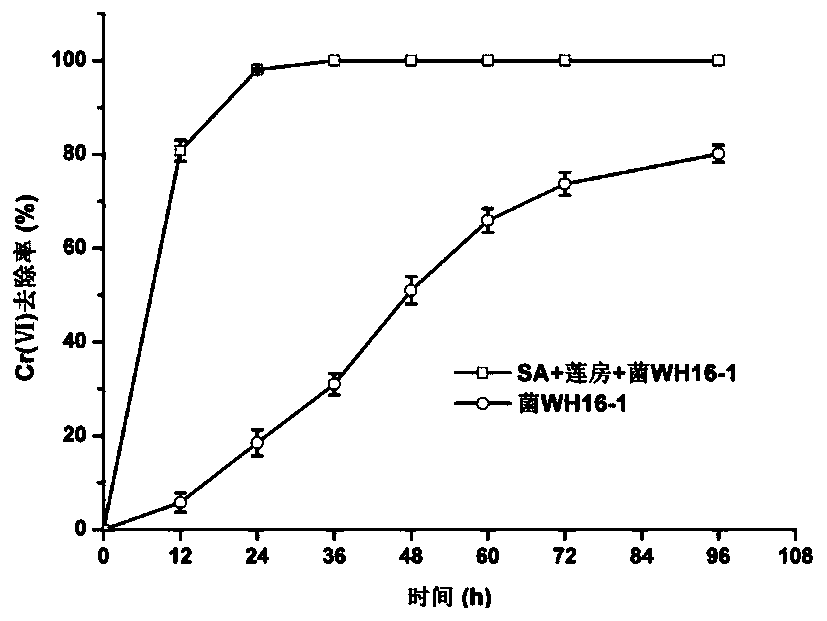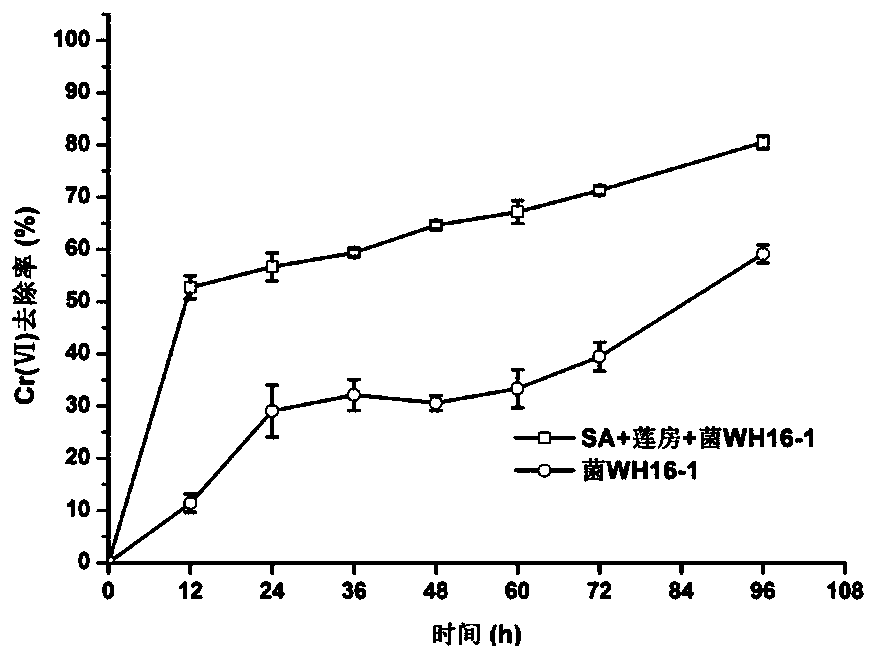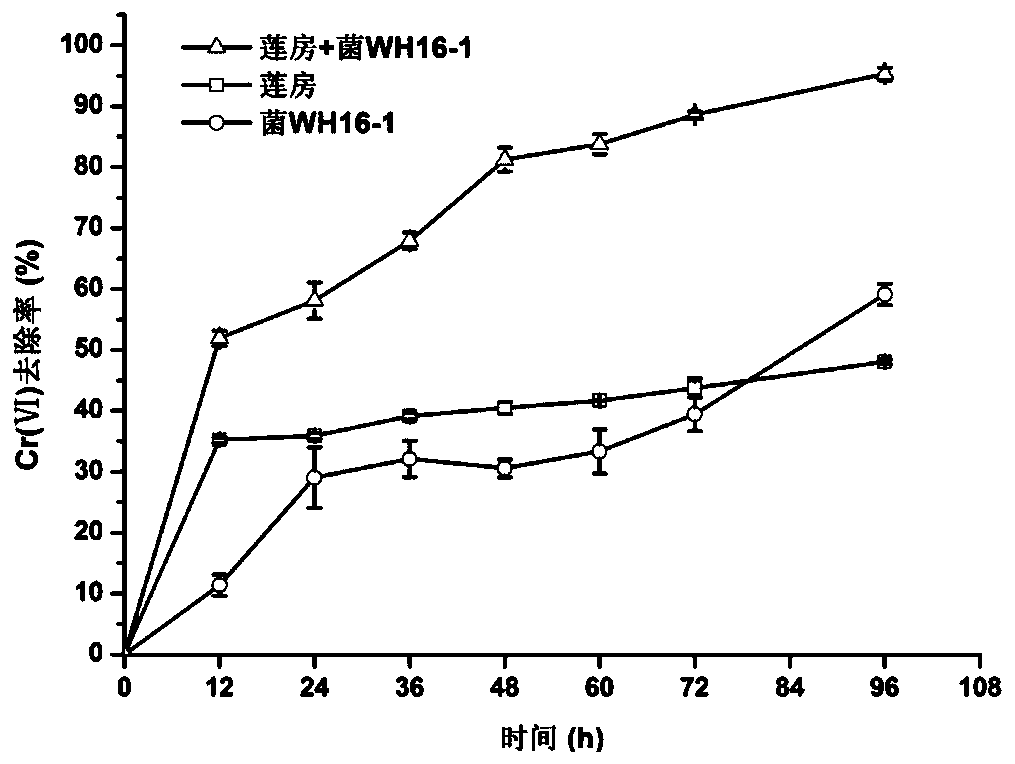A kind of lotus pod immobilized microorganism and its preparation method and application
A microorganism and lotus plant technology, applied in the field of materials and the environment, can solve the problems of pollution, cadmium and chromium pollution, waste of resources and the environment, etc., and achieve the effects of simple process, resource saving and pollution avoidance.
- Summary
- Abstract
- Description
- Claims
- Application Information
AI Technical Summary
Problems solved by technology
Method used
Image
Examples
Embodiment 1
[0031] A method for preparing microorganisms immobilized in lotus houses includes the following steps:
[0032] (1) Preparation of the lotus house: Collect the lotus house in an oven at 55°C, dry it to a constant weight, then pulverize with a grinder, pass through a 60-mesh sieve, and obtain powder for use;
[0033] (2) The lotus house contains microorganisms: a. Inoculate the WH16-1 bacterial solution with a volume fraction of 1% in the logarithmic growth phase in 100 mL of LB medium, and place it in a shaker at 37°C and 160 r / min. After 12h, centrifuge, discard the supernatant, and add 25mL of fresh culture solution; b. Add 0.5g of lotus powder from step (1) and 25g of sodium alginate solution with a mass fraction of 4% to the liquid obtained in step a. Stir to mix thoroughly; c. Pour the mixture obtained in step b into 100g of a calcium chloride solution with a mass concentration of 2%, let it stand for 24 hours and then pour out the liquid, wash the particles with saline, and f...
Embodiment 2
[0036] A method for preparing microorganisms immobilized in lotus houses includes the following steps:
[0037] (1) Preparation of the lotus house: Collect the lotus house in an oven at 55°C, dry it to a constant weight, then pulverize with a grinder, pass through a 60-mesh sieve, and obtain powder for use;
[0038] (2) The lotus house contains microorganisms: a. Inoculate the WH16-1 bacterial solution with a mass fraction of 1% in the logarithmic growth phase into 100 mL of LB medium, add 0.5 g of the lotus house and place it at 37°C, 160r / Cultivate in a shaker for 12 hours for 12 hours; then centrifuge and vacuum dry to obtain the lotus house with immobilized microorganism particles.
[0039] Take the above-mentioned lotus room with microorganisms immobilized in 100mL medium containing 500mg / L Cr(VI) (potassium dichromate), take samples after a certain period of time, filter the samples by centrifugation, and use diphenylcarbazide (DPC) spectrophotometry Method to measure the rem...
Embodiment 3
[0041] The test of the storage stability of the lotus leaf sodium alginate immobilized microorganisms:
[0042] The preparation of lotus palm sodium alginate immobilized microorganism is the same as in Example 1.
[0043] The same number of bacteria is 10 10 Cfu / mL free bacteria powder and lotus alginate sodium alginate immobilized microbial particles were stored in a dry environment at room temperature for 3 months, and then 1.6 g lotus alginate sodium alginate immobilized microbes and free bacteria powder containing the same number of bacteria were taken for 3 months. In 100mL of LB medium, place it in a shaker at 37℃ and 160r / min for 12h, then measure the number of bacteria in the solution by the dilution coating method, the count of free bacteria powder and microbial particles immobilized by lotus sodium alginate Respectively: 0 and 4×10 5 cfu / mL.
[0044] Take the lotus leaf sodium alginate that has been dried and stored for a certain period of time in 100 mL of medium, add pot...
PUM
| Property | Measurement | Unit |
|---|---|---|
| clearance rate | aaaaa | aaaaa |
Abstract
Description
Claims
Application Information
 Login to View More
Login to View More - R&D
- Intellectual Property
- Life Sciences
- Materials
- Tech Scout
- Unparalleled Data Quality
- Higher Quality Content
- 60% Fewer Hallucinations
Browse by: Latest US Patents, China's latest patents, Technical Efficacy Thesaurus, Application Domain, Technology Topic, Popular Technical Reports.
© 2025 PatSnap. All rights reserved.Legal|Privacy policy|Modern Slavery Act Transparency Statement|Sitemap|About US| Contact US: help@patsnap.com



